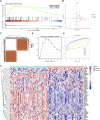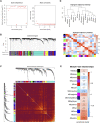Clinical Significance and Immune Landscape of a Pyroptosis-Derived LncRNA Signature for Glioblastoma
- PMID: 35223836
- PMCID: PMC8866949
- DOI: 10.3389/fcell.2022.805291
Clinical Significance and Immune Landscape of a Pyroptosis-Derived LncRNA Signature for Glioblastoma
Abstract
Introduction: Pyroptosis was recently implicated in the initiation and progression of tumors, including glioblastoma (GBM). This study aimed to explore the clinical significance of pyroptosis-related lncRNAs (PRLs) in GBM. Methods: Three independent cohorts were retrieved from the TCGA and CGGA databases. The consensus clustering and weighted gene coexpression network analysis (WGCNA) were applied to identify PRLs. The LASSO algorithm was employed to develop and validate a pyroptosis-related lncRNA signature (PRLS) in three independent cohorts. The molecular characteristics, clinical significances, tumor microenvironment, immune checkpoints profiles, and benefits of chemotherapy and immunotherapy regarding to PRLS were also explored. Results: In the WGCNA framework, a key module that highly correlated with pyroptosis was extracted for identifying PRLs. Univariate Cox analysis further revealed the associations between PRLs and overall survival. Based on the expression profiles of PRLs, the PRLS was initially developed in TCGA cohort (n = 143) and then validated in two CGGA cohorts (n = 374). Multivariate Cox analysis demonstrated that our PRLS model was an independent risk factor. More importantly, this signature displayed a stable and accurate performance in predicting prognosis at 1, 3, and 5 years, with all AUCs above 0.7. The decision curve analysis also indicated that our signature had promising clinical application. In addition, patients with high PRLS score suggested a more abundant immune infiltration, higher expression of immune checkpoint genes, and better response to immunotherapy but worse to chemotherapy. Conclusion: A novel pyroptosis-related lncRNA signature with a robust performance was constructed and validated in multiple cohorts. This signature provided new perspectives for clinical management and precise treatments of GBM.
Keywords: chemotherapy; glioblastoma (GBM); immune landscape; immunotherapy; long non-coding RNA; prognostic signature; pyroptosis.
Copyright © 2022 Xing, Liu, Fu, Zhou, Liu, Dang, Guo, Ge, Lu, Zheng, Dai, Han and Wang.
Conflict of interest statement
The authors declare that the research was conducted in the absence of any commercial or financial relationships that could be construed as a potential conflict of interest.
Figures







Similar articles
-
A Pyroptosis-Related LncRNA Signature for Predicting Prognosis, Immune Features and Drug Sensitivity in Ovarian Cancer.Onco Targets Ther. 2025 Apr 23;18:585-601. doi: 10.2147/OTT.S491130. eCollection 2025. Onco Targets Ther. 2025. PMID: 40291608 Free PMC article.
-
An innovative pyroptosis-related long-noncoding-RNA signature predicts the prognosis of gastric cancer via affecting immune cell infiltration landscape.Pathol Oncol Res. 2022 Dec 7;28:1610712. doi: 10.3389/pore.2022.1610712. eCollection 2022. Pathol Oncol Res. 2022. PMID: 36567977 Free PMC article.
-
Pyroptosis-Related lncRNA Prognostic Model for Renal Cancer Contributes to Immunodiagnosis and Immunotherapy.Front Oncol. 2022 Jul 4;12:837155. doi: 10.3389/fonc.2022.837155. eCollection 2022. Front Oncol. 2022. PMID: 35860590 Free PMC article.
-
Construction of prognostic markers for gastric cancer and comprehensive analysis of pyroptosis-related long non-coding RNAs.World J Gastrointest Surg. 2024 Jul 27;16(7):2281-2295. doi: 10.4240/wjgs.v16.i7.2281. World J Gastrointest Surg. 2024. PMID: 39087128 Free PMC article.
-
The role of pyroptosis in modulating the tumor immune microenvironment.Biomark Res. 2022 Jun 23;10(1):45. doi: 10.1186/s40364-022-00391-3. Biomark Res. 2022. PMID: 35739593 Free PMC article. Review.
Cited by
-
Construction and Verification of a Novel Pyroptosis-Related lncRNA Signature Associated with Immune Landscape in Gliomas.J Oncol. 2022 Oct 14;2022:7043431. doi: 10.1155/2022/7043431. eCollection 2022. J Oncol. 2022. PMID: 36281290 Free PMC article.
-
Identification of pyroptosis-related subtypes and establishment of prognostic model and immune characteristics in asthma.Front Immunol. 2022 Jul 28;13:937832. doi: 10.3389/fimmu.2022.937832. eCollection 2022. Front Immunol. 2022. PMID: 35967302 Free PMC article.
-
Shedding light on function of long non-coding RNAs (lncRNAs) in glioblastoma.Noncoding RNA Res. 2024 Feb 6;9(2):508-522. doi: 10.1016/j.ncrna.2024.02.002. eCollection 2024 Jun. Noncoding RNA Res. 2024. PMID: 38511060 Free PMC article. Review.
-
LncRNAs and regulated cell death in tumor cells.Front Oncol. 2023 May 29;13:1170336. doi: 10.3389/fonc.2023.1170336. eCollection 2023. Front Oncol. 2023. PMID: 37313458 Free PMC article. Review.
-
A novel pyroptosis-regulated gene signature for predicting prognosis and immunotherapy response in hepatocellular carcinoma.Front Mol Biosci. 2022 Sep 5;9:890215. doi: 10.3389/fmolb.2022.890215. eCollection 2022. Front Mol Biosci. 2022. PMID: 36262473 Free PMC article.
References
LinkOut - more resources
Full Text Sources

